
As usual, viewzone gave me a writing assignment about something of which I knew very little -- this time it was something called the electromagnetic pulse, or "EMP" weapon. As usual, what I learned from my research scared the hell out of me.
When I first sat down to write this story, America had no real enemy capable of using an EMP weapon. That's a good thing because, as you will learn, this is far more dangerous and potentially more lethal than a nuclear bomb. But now, as I am forced to re-write this article for publication, our old nemesis -- Russia -- has emerged as a potential foe. Not only do the Russians have EMP weapons but the likelihood of their use, especially if the geo-political tensions continue, is almost certain.
First, let me emphasize this: Unlike nuclear bombs that can destroy a large city like New York or Chicago, an EMP weapon is so powerful that just one -- detonated over the central USA -- could knock out the entire country. That's right -- just one!
EMP -- the worst weapon you will ever survive.
When I was a teenager I was a ham radio operator. I listened to my short wave radio for hours just about every day. I remember one summer in 1962 when I thought my receiver was broken; I even bought new tubes for it. On every band, on every frequency, there was a loud and annoying hiss that lasted for a couple of days. Communication was impossible.
 No one spoke about it on the news, nothing was written -- it was "top secret" at the time -- but I later learned that it was the result of an atmospheric nuclear explosion. The 1.4 megaton detonation, called "Operation Starfish Prime" [right] occurred 250 miles above Johnston Island in the Pacific. Not only did the explosion shut down short wave radio communications in America, but it also overloaded and blew out over 300 streetlights in Oahu, Hawaii -- some 740 miles away!
No one spoke about it on the news, nothing was written -- it was "top secret" at the time -- but I later learned that it was the result of an atmospheric nuclear explosion. The 1.4 megaton detonation, called "Operation Starfish Prime" [right] occurred 250 miles above Johnston Island in the Pacific. Not only did the explosion shut down short wave radio communications in America, but it also overloaded and blew out over 300 streetlights in Oahu, Hawaii -- some 740 miles away!
Scientists learned that nuclear explosions, in addition to the blast, heat and deadly gamma radiation, also produce a strong electromagnetic pulse that is capable of passing thousands of volts of electrical energy to just about anything that conducts electricity.
The pulse is generated by the interaction of gamma rays, released by a nuclear explosion, with the atmosphere and the Earth. Called the "Compton effect", the resulting pulse is like a radio signal and any metallic object acts like a receiving antenna. Whereas a radio signal might produce a thousandth of a volt or less in a receiving antenna, an EMP pulse produces thousands of volts. Antennae, pipelines, underground gas and water pipes, metal fences, iron railroad tracks, power lines, telephone wires, electric cables -- all suddenly act like antennae and become the recipient of huge currents, starting fires, explosions and frying all forms of circuitry beyond repair.
Because our bodies do not conduct this current, the EMP does not directly harm humans or other living organisms. But, as you will see, that's not necessarily good news.
Back to the stone age
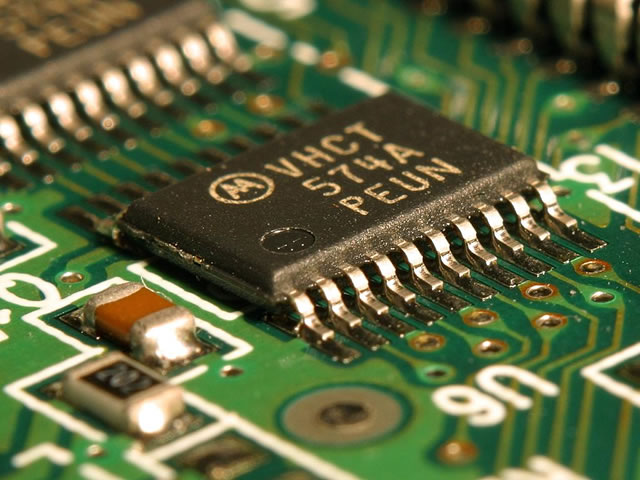 Look around you. Right now you are using a computer. You probably also depend on a cellphone and, most likely, you have a car to get you from home to work or to the market.
Look around you. Right now you are using a computer. You probably also depend on a cellphone and, most likely, you have a car to get you from home to work or to the market.
Most vulnerable to this high current of EMP are transistors, those small devices that are inside computer chips, radios, cellphones, ATM machines, automotive ingnition systems, calculators, clocks and just about everything that requires batteries. All of these would be useless after an EMP and repairing them would not be an option. They would all have to be replaced.
An EMP lasts just 1 nano-second! It radiates at 50 kv/m at the speed of light. At such a high altitude, it could happen in the blink of an eye and might not be immediately associated with any type of explosion or blast.
Imagine surviving an EMP only to find you cannot call your family to see if they are safe, cannot get cash from your ATM or bank (since they cannot access your records), cannot buy food at a supermarket (no scanners) or even drive your car (ignition destroyed). Everything relying on modern electrical technology will be useless.
When you finally walk to your home, city water will not be pumped, lights will not come on, sewage treatment will be off-line, heat and air conditioning will be gone and the production, harvesting and transport of food will have come to a grinding halt. What's even worst is that the lack of radio and television news will keep most people from understanding what has happened or how to respond. Confusion and eventually anarchy would reign. This is the reality of an EMP weapon.
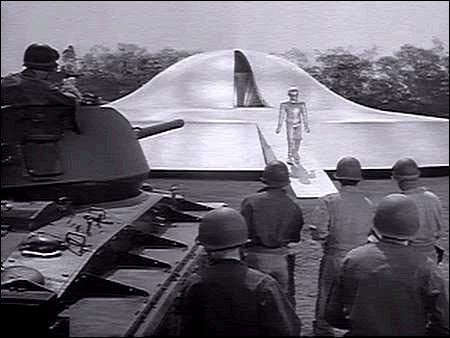
[above] In the film "The Day the Earth Stood Still," an alien visitor stopped every electrical apparatus all over the globe as a demonstration of his power. An EMP, although not effecting the entire world, would cause a similar catastrophe.
It is possible to shield electronic equipment from EMP radiation, but it is extremely difficult. The protected components must be completely enclosed in a copper shield. Even a small hole will allow the radiation to enter and any wires extending outside the shield will defeat the protection. For all practical purposes, this is not possible.
Air Force One, the President's jet, and certain other strategic aircraft have been equipped with special shields to reduce the effects of the radiation. Oddly, old radio equipment using vacuum tubes are less likely to be hurt by the radiation than transistor circuitry and many existing Russian aircraft still maintain these old systems for this reason.
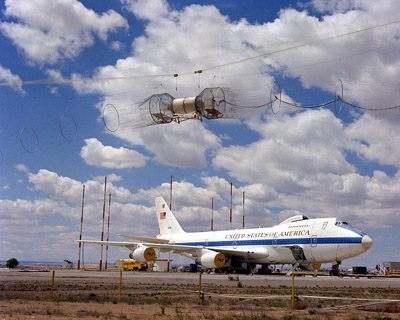
[Above] Special Air Force E-4 being tested for EMP shielding.
Just one is enough
This threat is not imaginary. The House Armed Services Committee issued its warning to Congress on July 10, 2008 citing the fact that the Russians have already tested small yield EMP weapons of 300 kilotons at altitudes of 60, 150 and 300 kilometers and produced the effects described above at distances up to 600 kilometers from the test site. An actual weapon would be many times stronger.
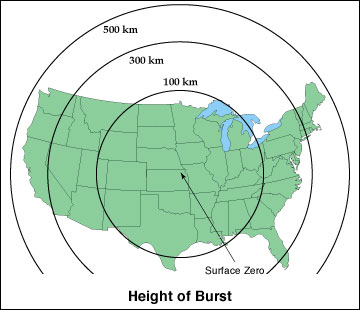
Areas of medium yield EMP destruction with a single burst over Kansas
at 100, 300 and 500 km.
The scientists describe three possible EMP effects, depending on the height of the detonation. Because the gamma rays travel in a line of sight path, the most dramatic effect comes from a high altitude blast. Here, the gamma rays can travel further and the Earth's magnetic field deflects the pulse back to the surface.
Such an attack could easily be launched from a submarine, just off the coast, and need not be accurate. The altitude and coordinates of detonation can vary widely and the effects will be just as lethal to the electronics. If several are launched, the chances of one reaching its optimum height is almost guaranteed. Once the EMP has been discharged, the circuitry of subsequent missile eletronics will be useless, leaving us vulnerable to more attacks.
The House Armed Services Committee confirmed that these weapons do not need to be accurately targeted to destroy our infrastructure. A medium size nuke, detonated from between 150 and 500 miles anywhere over Kansas, would be enough to destroy a hundred years of technological development. By comparison, the space shuttle and space station orbit about 110 to 150 miles above Earth, well below the optimal detonation of a potential EMP weapon.
An orbiting nuke could possibly already be poised, waiting to be used in a future conflict. If such a weapon is already up there, it is completely beyond our current capability to destroy it. Once it is detonated, our remaining electronic defense systems would be relatively useless. Checkmate.
But wait -- there's more!
Recently, scientists have developed a way to produce an EMP weapon without fissionable material. These non-nuclear devices are smaller than nuclear fueled pulse generators but their effect can be just as effective over a limited geographic area.
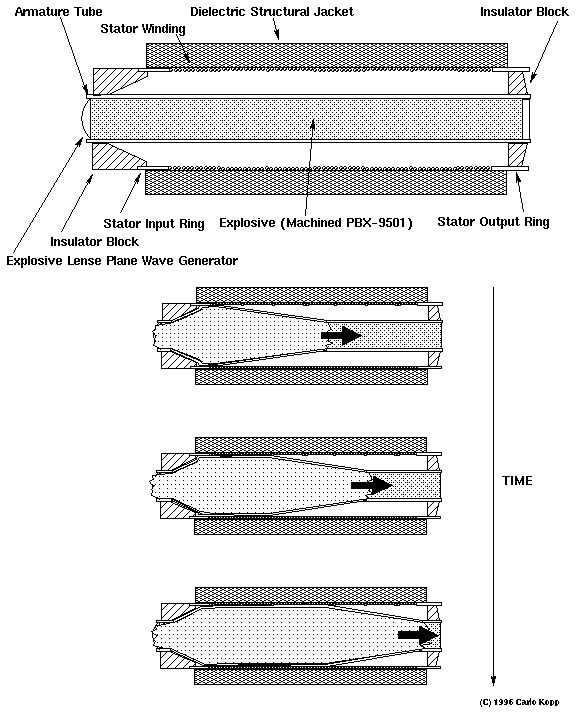
In the apparatus above, power is supplied by a bank of capacitors. These capacitors are similar to the system used to power a strobe flash. The ingition first charges the large coil, producing a magnetic field. Then an explosive charge begins at one end of the coil, shorting the coil by compressing it against the metallic shield. The effect changes the inductance of the coil, essentially shortening the field as the explosion advances down the tube.
The resulting electromagnetic pulse has a wide spectrum of wavelengths, capable of energizing metallic objects of varied lengths, from hundreds of feet to a few inches. All of the artificial "antennae" then become charged with enormous electrical currents which burn and render their components useless.
This type of non-nuclear apparatus is almost impossible to detect but is limited in scope and power by the size of the charging capacitors.
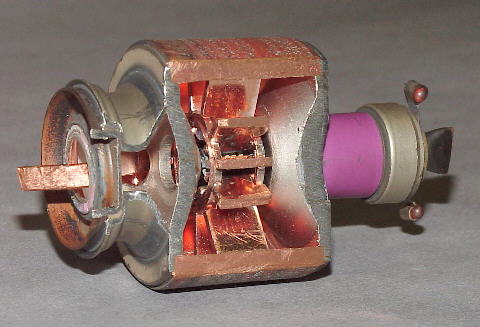
[above] Inside an industrial magnetron.
Some smaller devices could easily be made by terrorists. In fact, a simple search of the internet yields plans and secifications for constructing small EMP devices from readily available components such as the megatrons from industrial microwave ovens, rated at 800 to 1200 watts, and several automotive batteries. These devices are said to be able, with the addition of a parabolic reflector, to disable the electronics of a modern car or truck within 200 meters.
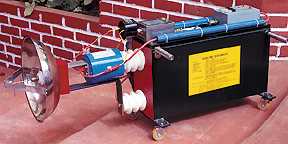 Commercially sold shock wave generators [right] are capable of producing focused acoustic or electromagnetic energy that can break up objects such as kidney stones and other similar materials. EMP generators can produce pulses of electromagnetic energy that can destroy the sensitive electronics in computers and microprocessors. Destabilized LCR circuits can produce multi megawatt pulses by using an explosive wire disruptive switch to achieve an effect similar to larger EMP devices.
Commercially sold shock wave generators [right] are capable of producing focused acoustic or electromagnetic energy that can break up objects such as kidney stones and other similar materials. EMP generators can produce pulses of electromagnetic energy that can destroy the sensitive electronics in computers and microprocessors. Destabilized LCR circuits can produce multi megawatt pulses by using an explosive wire disruptive switch to achieve an effect similar to larger EMP devices.
The point here is not to make you go out and build an EMP weapon. It is to make you aware that the technology is very real and that we are currently extremely vulnerable to the effects of this type of weapon. Nations, like the US and Russia, have already developed these weapons on a scale capable of devastating our modern, technological dependent civilization.
Should you be paranoid? Well, I know some people who have stopped putting their money in banks and have started storing food and water. Collecting books on farming and gardening is another good idea. Some are even exercising more, getting ready for long walks along deserted highways and roads.
What will you do?




No comments:
Post a Comment